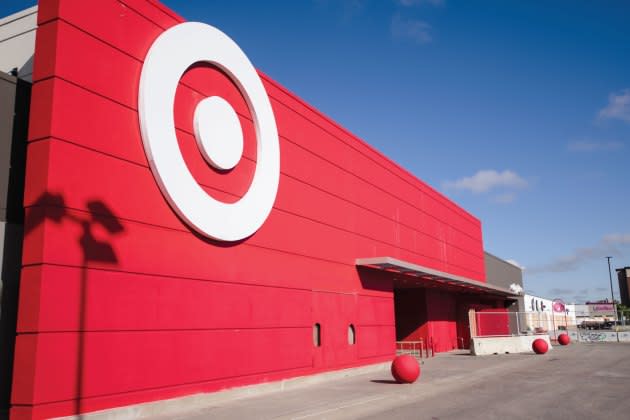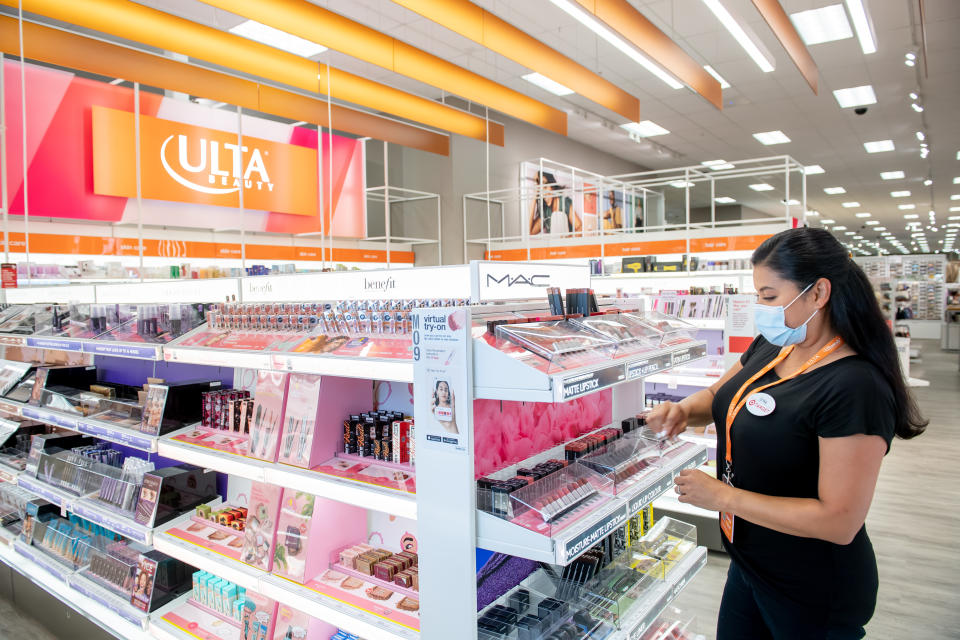Target’s Profits Fall by Nearly 90 Percent

Target’s excess inventory issues are cutting into quarterly profits.
The big-box retailer revealed earnings Wednesday before the market opened, improving on top-line sales but falling short on bottom-line profits by nearly 90 percent thanks to rapidly changing consumer shopping patterns and a plethora of unwanted products.
More from WWD
Continued inventory issues, along with increased markdowns and rising prices during the three-month period ending July 30 caused the company’s profits to fall nearly 90 percent to $183 million, down from $1.8 billion a year ago. Second-quarter earnings per share were down more than 89 percent to 39 cents each, compared with $3.65 a year ago.
Still, Brian Cornell, chairman and chief executive officer of Target Corp., said in a statement that he was pleased with the company’s performance in the most recent quarter.
“[Target] continues to grow traffic and sales while delivering broad-based unit-share gains in a very challenging environment,” he said. “I want to thank our team for their tireless work to deliver on the inventory rightsizing goals we announced in June. While these inventory actions put significant pressure on our near-term profitability, we’re confident this was the right long-term decision in support of our guests, our team and our business. Looking ahead, the team is energized and ready to serve our guests in the back half of the year, with a safe, clean, uncluttered shopping experience, compelling value across every category and a fresh assortment to serve our guests’ wants and needs.”
The CEO added on Wednesday morning’s conference call with analysts that “the vast majority of the financial impact of these inventory actions is now behind us. This positions our business to deliver a meaningful improvement in operating margin rates in the fall season.”
The company canceled more than $1.5 billion in fall season receipt orders in discretionary categories to help curb costs.
But investors didn’t seem convinced. Shares of Target closed down 2.6 percent to $175.50 apiece Wednesday. Year-over-year, Target’s stock is down more than 29 percent.
Top-line, quarterly numbers were more favorable. Total revenues for the three-month period were more than $26 billion, up from $25.1 billion a year ago. Total comparable sales grew 2.6 percent for the quarter, year-over-year, while store comparable sales rose 1.3 percent, with continued strength in the food and beverage, beauty and essentials categories. Digital comparable sales increased 9 percent, while same-day fulfillment services — including buy online, pick up in store, drive-up and Shipt — grew nearly 11 percent. The biggest gains were in drive-up, which increased in the midteens range.
“We applaud [Target] for taking an aggressive stance on rightsizing its inventory levels as opposed to dealing with this issue for several quarters or potentially years,” Arun Sundaram, senior equity analyst at CFRA Research, wrote in a note. “We expect [Target] to be in a much stronger inventory position in [fall] [fourth quarter], setting the company up for a much stronger [fiscal-year] 2024. That said, we have concerns about slowing comp sales growth.”
His firm maintained a “hold” position on the stock, but set a new, higher 12-month price target of $190 a share.
The retailer said it still expects full-year revenue growth in the low- to midsingle digit range, compared with last year’s results, and is anticipating an operating margin rate around roughly 6 percent in the back half of the year, year-over-year.
Target’s inventory balance sheet, perhaps its biggest headwind for the quarter, remained around $15 billion between the first and second quarters. That’s approximately $6 billion above pre-pandemic levels. But Michael Fiddelke, executive vice president and chief financial officer, pointed out that about $3 billion of that amount is because of higher unit costs across the assortment.
In addition, John Mulligan, executive vice president and chief operating officer, said cutting fall receipt orders was “huge for us, because of the uncertainty in those particular categories. That really de-risks those categories going forward.”
The company has also temporarily secured storage containers near ports and moved to earlier receipt dates for season inventory in an attempt to rely less on airfreight moving forward.
“While pressure from excess inventory has presented the biggest challenge to our team this year, dealing with high costs and volatility in the external supply chain has run a close second,” Mulligan said. “When needed, [the containers] allow us to quickly clear the containers from the port area and hold them until the ideal time to begin moving inventory into our supply chain network.
“While conditions remain far from what we would have considered normal in the years before the pandemic, there are early signs that both costs and volatility may have peaked,” he added. “More specifically, lead times in global shipping have begun to decline; spot rates to move shipping containers have fallen somewhat. And in light of the reduction in petroleum prices we’ve all seen recently, fuel surcharges have been easing somewhat compared with the peak rates we saw earlier in the second quarter. That said, conditions remain highly unfavorable when compared to the years before the pandemic and we’re mindful of the continued risks in the months ahead, including potential slowdowns at the West Coast ports, a reversal of the recent decline in energy costs and the possibility of additional COVID [-19] lockdowns in China.”
The firm is anticipating an impact of roughly $200 million in the current quarter from inventory reductions.
Meanwhile, changing consumer shopping patterns might actually serve as both a headwind and a tailwind, Christina Hennington, the retailer’s executive vice president and chief growth officer, said on the call.
“What we’re seeing in our results and hearing from our guests is that they still have spending power, but they’re increasingly feeling the impact of inflation,” she explained. “Against that backdrop, we’ve seen our guests shop our own brands in bigger ways and more frequently. We’ve also seen guest behavior evolve as they focus on optimizing their personal budgets through a heightened response to promotions, as well as greater trip consolidation. At the same time, guests continue to experience difficult news headlines, COVID [-19] surges and continued political volatility, leading them to seek more ways to celebrate, connect and find opportunities to bring joy to their families. This is one of the reasons we continue to see such strength in our seasonal categories, which we expect will continue in the back half of the year.”

Courtesy Photo
Target shoppers continued to stock up on pet, health care, food and beauty categories during the most recent quarter. Hennington added that Target remains on track to open at least 250 Ulta Beauty shops-in-shop by the end of the year.
Headwinds included home and hardline categories, driven by softness in electronics, but partially offset by strength in entertainment and toys. Overall apparel sales also declined during the quarter. But Hennington said specific categories — such as fashion-forward clothing and performance apparel — continued to grow.
The Minneapolis-based company revealed its latest quarterly earnings just one day after Walmart, which also said it struggled with excess inventory in some categories — also in home, electronics and apparel — but still grew on both top and bottom lines thanks to gains in the grocery category.
“We believe [Walmart’s] higher grocery and grocery inflation exposure versus [Target’s] helped [Walmart],” Oliver Chen, managing director and senior equity analyst at Cowen, wrote in a note. Still, he added, “we believe the valuation remains compelling despite the miss. [Target] is well positioned for a strong back-to-school season with improved inventory positions versus [last year]. Also, Target should benefit as consumers ‘celebrate joy’ given [Target’s] partnerships with Lego, Marvel and others, merchandising expertise and history of executing well around events, holidays [and] occasions.”
His firm rated Target’s stock “outperform.”
Target ended the quarter with more than $1.1 billion in cash and cash equivalents and $13.4 billion in long-term debt.
Sign up for WWD's Newsletter. For the latest news, follow us on Twitter, Facebook, and Instagram.